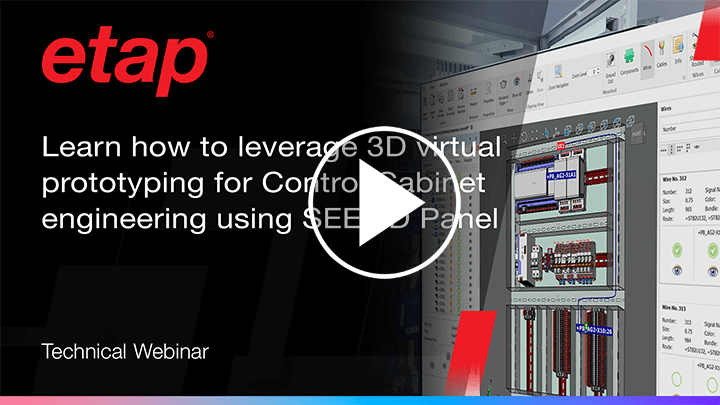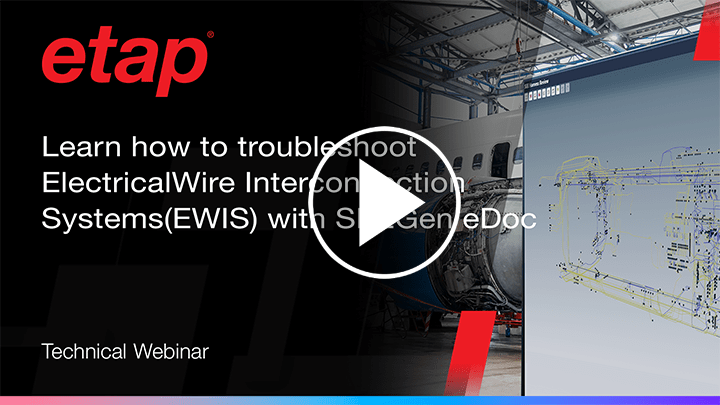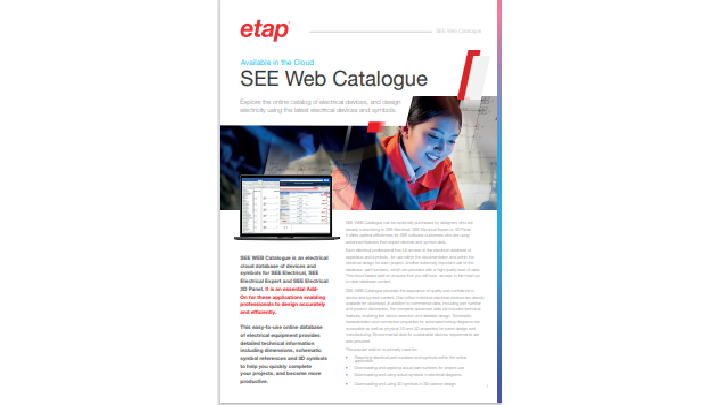Recent Trends
346 Item(s) found

Learn how to maximize uptime and optimize microgrid operations
- 20:31
- Webinar
Learn about ETAP Microgrid, an integrated solution used to efficiently evaluate and optimize microgrid systems. The solution enables simulation and hardware-in-the-loop testing for microgrid systems using data-driven technology and built-in functions. This presentation covers the definition of a microgrid, the integration of various energy sources, and the importance of high performance solutions for enhancing energy resilience. Demonstrations of specific scenarios are provided for both grid-tied and off-grid microgrids. The hardware-in-loop testing capabilities are also demonstrated, showcasing the real-time digital simulator and its application for testing and validating microgrid controller functions. By addressing the complexities of microgrid system analysis, management, and control, ETAP Microgrid contributes to cost and time-saving benefits.

Learn how to achieve grid code compliance with ease using ETAP Software
- 19:23
- Webinar
Learn how ETAP Grid Code improves grid interconnection studies and compliance checks. This presentation provides a walkthrough of ETAP’s advanced modeling capabilities and study modules which alleviate the challenges of manual processes, including integration of rulebooks with load flow, short circuit, protective device coordination, transient stability and harmonic analysis. Interconnection studies are vital for the power sector's shift to sustainable energy, ensuring the safe, secure, and efficient operation of connected power plants. By streamlining compliance checks and ensuring that grid code requirements are met, the time-saving solution offered by ETAP offers a much-needed comprehensive solution for grid interconnection studies.
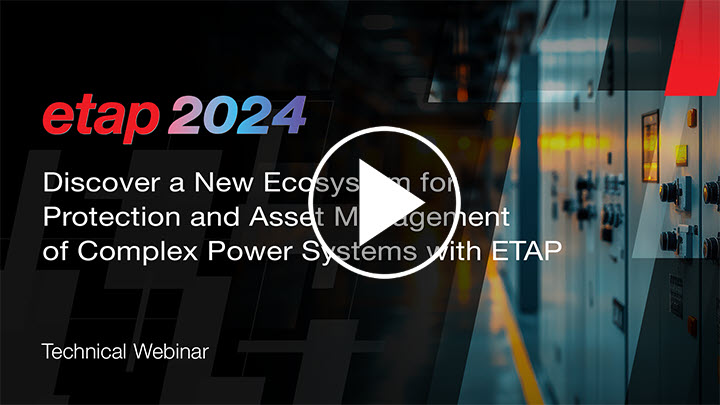
Discover a New Ecosystem for Protection and Asset Management of Complex Power Systems with ETAP
- 18:42
- Webinar
Learn about the unique challenges faced by engineers and operators to ensure the health and maintenance of their electrical systems, and how ETAP’s eProtect protection and asset software, and ETAP Digital Twin enable utilities and power system operators to achieve a higher level of reliability, efficiency, and safety in their operations. You’ll learn how how the effective integration of hardware resolves many of the complexities of relay protection setting management.
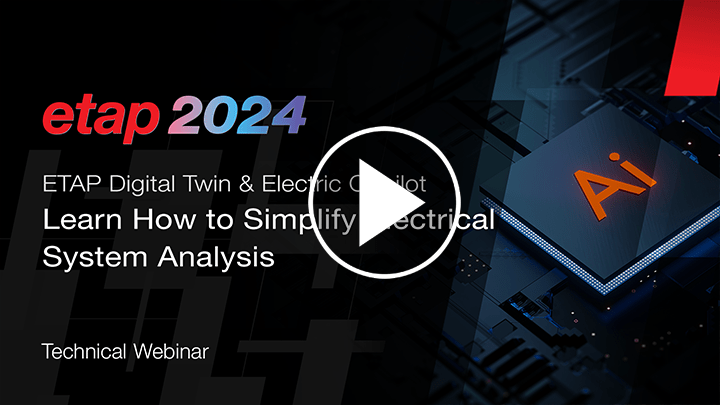
Learn How to Simplify Electrical System Analysis with ETAP Digital Twin & Electric Copilot
- 15:17
- Webinar
Learn how ETAP's Simplified Electrical Digital Twin and Electric Copilot™ are helping to solve the key challenges being faced in electrical design and analysis, such as increasing system complexity, aging infrastructure, demand for real-time data, regulatory pressure, and skill gaps. The product demonstration illustrates the innovative and newest features of ETAP, including new modeling functionality, document tagging, composite networks, component classification, advanced preferences, and artificial intelligence with Electric Copilot.

Learn About Integrating Wind Turbines for FPSO Optimal BESS Sizing using ETAP & PSCAD Co-simulation
- 19:49
- Case Study
The transition towards sustainable energy sources is driving innovative solutions in the offshore oil and gas industry. The presentation delves into the integration of a Wind Turbine Generator (WTG) into an existing Floating Production Storage and Offloading (FPSO) vessel to reduce carbon emissions. The technical and operational challenges of this integration are discussed, including load balancing, intermittency of wind energy, transformer energization, motor starting, protection coordination, and maintaining operational reliability. The study utilizes simulations with tools like HOMERPRO, ETAP, and PSCAD to assess the technical feasibility of integrating the WTG and Battery Energy Storage System (BESS) into the FPSO power system. Various studies, including load flow, short circuit, motor acceleration, transient stability, voltage ride through, harmonic analysis, protection coordination, and transformer energization are conducted to ensure the effectiveness and efficiency of the proposed system. There is great potential for reducing the operational carbon footprint of FPSOs by incorporating renewable energy sources and using software simulations to address the complexities and considerations involved in such integration.

How to Optimize Green Hydrogen Projects Using ETAP and Digital Twin Technology for Efficiency
- 17:24
- Case Study
This case study focuses on a green hydrogen project that applied a digital twin solution. The project is a 1.4 gigawatt wind farm in China, involving green hydrogen and ammonia manufacturing, with an estimated investment of $1-2 billion. The customer recognized the need for a software solution to optimize their processes and was looking for comprehensive coverage from power management to process management. The project's objectives included sizing optimization to reduce CapEx costs, process verification and optimization, and digital tools for control system specifications and electrolyzer selection. The digital continuity and unified digital solution offered by Schneider Electric encompassed feasibility study, detailed design, and future operation and maintenance stages. The project's complexity required linking power and process data, utilizing ETAP and AVEVA software solutions for modeling and simulation, and employing digital twin technology for process control. The proposed approach included utilizing ETAP for energy transition engineering, emphasizing the value of ETAP software applications, and leveraging software services to ensure the success of the implementation. The study also highlighted the value of digital continuity and building trust with the client to ensure the success of the project.
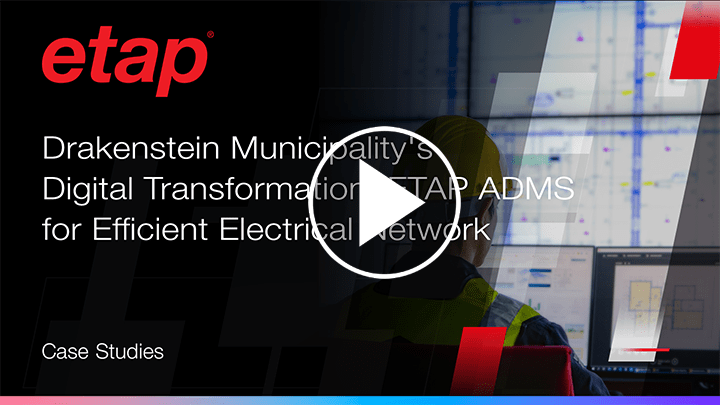
Drakenstein Municipality's Digital Transformation: ETAP ADMS for Efficient Electrical Network
- 10:47
- Case Study
Drakenstein is a municipality in the western Cape province of West Africa supporting the electrical needs of 5 towns and close to 300,000 people. With limited visibility for our existing electrical network, the decision was made to upgrade the legacy equipment. With this, our vision is to embark on a digital journey to improve network efficiencies, reduce downtime, time of outages, and inadvertent tripping. In this case study, the phased approach to this transformation will be discussed, and the use of ETAP applications, analysis modules and the implementation of a digital twin to design and model the new electrical network. The presentation covers the use of ETAP load flow, short circuit, protection and relay coordination studies and subsequent hardware design planning and visualization using ETAP PSMS.

Learn How Weidmueller Improves Manufacturing Efficiency with the SEE Electrical Software Suite
- 16:27
- Case Study
Weidmueller is a pioneer of industrial connectivity, with customers around the world involved in building electrical control cabinets. In this case study, you’ll gain a better understanding of the complexities and bottlenecks in a traditional manufacturing workflow, and how Weidmueller has applied new strategies that work with software solutions such as SEE Electrical to improve efficiency at various phases. The demonstration includes the data engineering connection with ETAP SEE Electrical, SEE Electrical Expert, and SEE 3D Panel+, and how these tools are used by customers to greatly improve wire processing and panel building.
